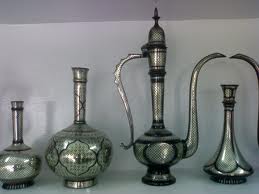This craft uses the techique of inlaying sliver and gold on steel or copper on the black background. In Bidar the crafsman started using blackened alloy of zinc and copper and polishing the wares with mud from the fort of Bidar to give it its distinctive black color and thats how the craft got its name.
First, a mould is formed using soil, castor oil and resin; molten metal is then poured into it to obtain a cast for the article. The casting is then coated with a strong solution of copper sulphate to give a temporary black coating over which designs are engraved and inlaid. The article is further smoothened by filing, polished using the Bidar fort mud, rubbed with coconut oil to enhance its blackness. The final product is brillant black article with silve or gold inlay.
Popular Bidri wares are Hookah, Vases, Decanter etc with Mughal motifs of flower. leaf and vine patterns and verses in Arabic from Quran.
Production Clusters : Hyderabad, Secunderabad.
Raw Materials Used : Zinc, Copper, Silver, Gold wire, Yellow Clay, Castor oil, Beeswax ( From Hyderabad)
Resin, Bidari matti ( From Bidar Fort)




